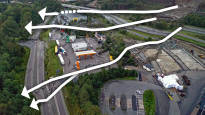Dangerous running clay moved under the road and burst through the asphalt, according to the experts interviewed by .
Mikko Pesonen,
Reeta Cremin,
Pekka Pantsu
The ground gave way last night under the E6 motorway in western Sweden near the Stenungsund settlement.
The highway broke in several places up to 500 meters away. The collapsed area is large, no less than 16 hectares.
We looked at an aerial photo of the accident scene with an expert. Manager Leena Korkiala-Tanttu Aalto University’s Department of Construction Technology uses the image to estimate what probably happened last night.
The picture shows how the embankment next to the highway seems to have collapsed.
According to Korkiala-Tantu, the collapse of the embankment has probably started the landslide by pushing the clay beneath the ground forward.
The clay under the ground has started to move and eventually the surface of the ground has broken at least in the three points indicated by the arrows, Korkiala-Tanttu notices.
– A small collapse has quickly spread over a wide area.
The third picture shows how the clay has protruded onto the ground in the cracked places.
– When the clay collapses, it yellows upwards. The collapse continues until there is no more collapsible material, says Korkiala-Tanttu.
Combined effect of rain and construction work?
Also a Finnish geotechnical expert, professor Minna Karstunen reviews the landslide for .
– It has been raining terribly here in the last couple of months. You could almost say it was only a matter of time before something like this happened.
Karstuse also has local knowledge of the landslide area that happened last night in Sweden. He works as a professor at Chalmers University of Technology in Gothenburg, which is only a few tens of kilometers from the accident site.
The cause of the massive collapse is still unknown. However, according to Professor Karstunen, it is possible that it is not only related to the heavy rains, but also to the ongoing construction works in the area.
– According to research, the majority of large landslides are caused by humans.
In Sweden, the police have started a preliminary investigation into the landslide. The police plan to interview, among other things, the personnel of the construction site of the nearby business park.
It is also possible that the collapse was caused by the combined effect of rain and construction work.
According to Karstusen, the investigation into the cause of the accident may take longer, as there is still a risk of collapse in the area.
– There are often additional setbacks. If the rain continues, it may take weeks before the risk of collapse is over.
Difficult running clay
Last night’s accident is not the first of its kind in western Sweden.
In 1977, a large landslide occurred on the island of Hisingen, located near the accident site. The same E6 highway was damaged in a landslide in 2006.
According to Professor Minna Karstusen, the area stretching from Western Sweden to Norway is particularly sensitive to landslides. It is due to the soil of the area and the loam on its surface.
– Clay is quite strong if it is not disturbed. But if there is, for example, a vibration or a sudden increase in pore pressure, it can trigger an avalanche.
An increase in pore pressure can be caused, for example, by heavy rains, which increase the water content of the clay and make it an unstable substrate.
Korkiala-Tanttu says that the instability of the clay caused by rain is due to the fact that the salt that binds the clay dissolves from the clay due to excessive water.
Rain records have been broken on the west coast of Sweden this summer. Since the beginning of June, more than 420 millimeters has rained near the accident site, ‘s meteorologist confirms Anne Borgström.
According to Karstusen, the risk of a large landslide in Finland is low.
– The risk area is mainly the coast of Southwest Finland, the Turku region, which has clay soil. I myself was planning the Turku-Helsinki motorway in the 1990s, and the matter was taken into account, for example the bridges were built longer than normal.
According to Karstunen, the problematic quicksand clay in Finland is also significantly deeper than in western Sweden, which reduces the risk of collapse.
More on the subject:
Some of the locals knew to wait for the Swedish highway accident
